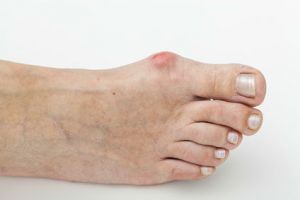
We often take our ability to walk for granted. But foot pain can quickly stop you in your tracks and not only leave you sidelined from your favorite activities, but can make even simple tasks a painful experience.
If you’ve ever suffered from foot pain, you’re not alone. A survey commissioned by the Institute for Preventative Foot Health found that 80 percent of individuals over the age of 21 experienced at least one foot-related condition in their lifetime. Of those individuals, 59 percent had sought out the help of a specialist.
The survey also found a link between foot health and BMI (body mass index). People with a BMI over 30 were 51 percent more likely to rate their foot health fair to poor while those who fell in the obese category were 41 percent more likely to have experienced a problem with their feet that left them in “a lot of pain.”
Keeping your weight in check and exercising regularly are key to maintaining proper foot health, but they won’t keep you immune from aching tootsies. Here are five common foot conditions and what you can do if they strike.
1. Bunion: Derived from the Latin word for turnip, a bunion resembles a bump along the outside of the big toe joint and occurs when the joint becomes misaligned, causing it to bulge out. Bunions are typically a result of genetics coupled with poor biomechanics. Years of walking with a certain gait can cause the ligaments to weaken and allow for the joint to move out of its proper alignment.
You can’t remove a bunion without surgery, which should only be considered as a last resort. But you can reduce any pain by wearing proper-fitting shoes with a large toe-box and opt for shoes made from softer material that will conform to the bulging joint without constricting it. Exercises to strengthen the surrounding ligaments and tendons can also help prevent any further deformation of the joint.
2. Plantar Fasciitis: Often the bane of runners, plantar fasciitis refers to the inflammation of the fibrous tissue that runs along the bottom of the foot known as the plantar fascia. Pain is usually experienced directly under the heel and is worse after periods of rest. Plantar fasciitis generally affects runners who have upped their mileage or intensity or those who are overweight and wear flat shoes regularly.
Proper footwear and arch support can help prevent the onset of plantar fasciitis and non-weight-bearing strengthening and stretching exercises can help strengthen the plantar fascia, Achilles tendon and calf muscles, tackling all three components of the condition.
3. Morton’s Neuroma: Tight, pointed and ill-fitting shoes are often to blame for this painful foot condition. When the bones of the third and fourth toes are forced to rub up against each other they can pinch the nerve that runs between them.
The pain is often experienced between the two toe bones and is often described as a tingling or numbness. Resting the foot and icing the area can treat the neuromas and a change in footwear is often recommended, especially if you are on your feet for long periods of time.
4. Hammer Toe: Pointed heels are also to blame for the development of hammer toes. Scrunching your feet into too tight of a shoe can cause the joint of the big toe to push against the second toe. So rather than lying flat with the others, the second toe becomes elevated and the pressure on the joint can cause a fair amount of pain.
Often a splint designed to take the pressure off of the joint is prescribed and roomier shoes can make walking more comfortable. Surgery to remove some of the bone around the joint is an option but should only be considered as a last resort.
5. Corns and Calluses: Hammer toes, bunions and ill-fitting shoes can lead to the development of corns and calluses. These are layers of thick dead skin that develop from constant friction. When they’re on the bottom of the foot they’re known as calluses and are called corns when they develop on top of the toes.
The easiest way to avoid corns and calluses is to wear shoes that fit, but once they’ve developed there are a few things you can try. Rubbing the area gently with a pumice stone and applying an organic moisturizing cream will eventually reduce their size.
 If they are very large, you can visit a podiatrist who can shave them down in a sterile environment. Avoid nail salons or other potentially germy areas until the skin is completely healed.
If they are very large, you can visit a podiatrist who can shave them down in a sterile environment. Avoid nail salons or other potentially germy areas until the skin is completely healed.
With all of this talk of foot problems, follow the best advice of all, wear shoes that fit!
-The Alternative Daily
Sources:
http://www.muschealth.com/gs/healthtopic.aspx?action=showpage&pageid=P00914
http://healthyliving.msn.com/health-wellness/how-to-fix-5-common-foot-problems?ocid=vt_twmsnhlt
http://www.ncbi.nlm.nih.gov/pmc/articles/PMC1183444
www.ipfh.org/images/research_materials/2012_National_Foot_Health_Assessment_June_2012.pdf
http://www.huffingtonpost.com/2012/06/28/foot-problems-issues-feet-health_n_1628246.html#slide=1148026

